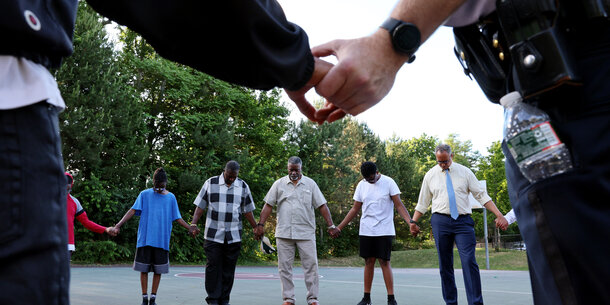Covid-19 brought new attention to the abhorrent conditions in our country’s overcrowded jails and prisons, which saw huge coronavirus outbreaks. Despite some early gains through local jails reducing their populations, prison populations across America saw almost no decline, and jail populations were creeping upward again by November.
Some local and state actors have attempted to adjust their criminal legal systems and incremental gains have been made, but there has been resistance to Covid-inspired reform in much of the country. This reluctance to embrace change has left thousands of people languishing behind bars. In the week of June 1 alone, there were at least 310 new cases of Covid-19 in prisons in the United States.
Incarcerated populations and the denial of compassionate release
In the first months of the pandemic, jails across the country reported rapid population reductions, with the national total dropping 18 percent during March 2020, followed by another 11 percent drop by the end of April. But those changes did not last, and by November, jail populations were rising again, encouraging the rapid spread of Covid-19 in prisons and jails through overcrowding.
In at least one study, holding people in jail for even just for a few hours or days was strongly associated with the spread of Covid-19. In Chicago, each person released in March 2020 led to about five additional cases of Covid-19 in that person’s zip code. Aside from the few governors who took direct action, most states did not take analogous steps to reduce their prison populations, and by April 2021, numerous studies had linked this failure, among other factors, to heightened Covid-19 outbreaks inside facilities.
An important element in this refusal to lower prison populations was the denial of compassionate release petitions, which have been filed by tens of thousands of incarcerated people, largely to no avail. In the first three months of the pandemic, almost 11,000 federal prisoners applied for compassionate release. Ninety-eight percent of those petitions were ignored or denied by correctional officials. On February 29, 2020, the Federal Bureau of Prisons held 146,036 people its adult facilities. On May 13, 2021, the number had risen to 152,376. Rather than take the onset of the pandemic as an opportunity to seriously decarcerate, the federal prison system extended its reach.
For people incarcerated in state prisons, the compassionate release process is even more complicated than in the federal system, as laws vary state to state — but releases have been comparably rare under those varying criteria, too. State parole boards also approved fewer releases in 2020 than in 2019, despite the public health crisis. And even dozens of individuals who had already been approved for release by a parole board (or were being held in jail without a conviction) died behind bars in the past year.
Some states, such as California and New Jersey, took deliberate steps to lower their state prison populations during the pandemic. However, even after reducing its incarcerated population by roughly 22 percent over the past year, California’s prison system is still operating at 103 percent capacity. Across all 50 states, the average prison population dropped 17 percent between January 2020 and January 2021 — yet the limited available data indicates that these reductions were mostly due to reductions in prison admissions, not releases.
Vaccinations behind bars
On March 30, a New York judge ordered Gov. Andrew Cuomo to offer Covid-19 vaccines to people incarcerated in the state, a departure from the existing state policy to only allow certain high-risk individuals behind bars to get vaccinated. The decision came nearly two months after several incarcerated people filed a lawsuit demanding access to the vaccine. Across the country, many state governments similarly resisted calls to vaccinate incarcerated individuals, and court orders to force universal rollouts are becoming more common.
By mid-May, at least some incarcerated individuals in all 50 states have been made eligible to receive the vaccine, though most states lack comprehensive plans for vaccinating people in juvenile facilities. And in immigration detention facilities, Immigration and Customs Enforcement has consistently sought to downplay its responsibility to vaccinate those in its custody, instead suggesting that people should sue the Centers for Disease Control and Prevention to get vaccinated.
Where incarcerated people can opt into the vaccine, numerous issues have emerged. On May 6, staff at a state prison in Washington administered 208 Moderna vaccine doses that were past their “beyond use” dates to incarcerated people. In Iowa, staff at a state penitentiary vaccinated at least 77 people incarcerated at the institution with six times the recommended dose of the Pfizer Covid-19 vaccine.
In contrast to the refusal to prioritize or failure to properly administer vaccinations for incarcerated people, some states have taken necessary steps to educate incarcerated individuals about the vaccine and to encourage widespread acceptance. In California, which is aiming for 80 percent of people incarcerated in its prison system to get vaccinated, prison officials have been engaging with credible messengers in and outside of the carceral system to encourage vaccinations among people behind bars. In Illinois, the Department of Corrections designated specific currently incarcerated people to be vaccine ambassadors, who were given the chance to ask questions of doctors and nurses about the vaccines and then assigned to work as peer educators in their facilities. These models of providing ample information and opportunities to receive the vaccine is critical to ending the coronavirus crisis within prison walls.
Other states have also begun incentivizing Covid-19 vaccinations by offering goodie bags or commissary credit in exchange for volunteering to be vaccinated. Despite these efforts, getting most incarcerated people protected against the virus is not the final solution to outbreaks in carceral settings, since employees coming in and out of facilities are very likely to transmit the disease unless they are also vaccinated. However, prison staff across the country are refusing the vaccine en masse, making the quest for herd immunity seem largely impossible. By May, many months into the vaccine rollout, only 55 percent of people in prison had been vaccinated — though the number varies greatly state by state.
Financial obstacles in the criminal legal system
Recognizing the financial and public health obstacles presented by the pandemic, some states implemented positive initial steps toward reducing the harms of fines and fees in their court systems. But in many places, emergency measures implemented during the pandemic will not stay in place or have already been reversed.
In the District of Columbia, tickets for parking infractions were suspended last year but resumed in full on June 1. Similarly, at the beginning of the pandemic, Iowa Gov. Kim Reynolds suspended the delinquency of court debt not paid within 30 days, but then repealed this proclamation by July. Other states instead chose to view the pecuniary challenges brought about by the pandemic’s economic downturn as a chance to further extract wealth from vulnerable communities. In states such as Alabama, courts are intercepting incarcerated people’s federal stimulus checks to pay off fines and fees. In Colorado, portions of some people’s pandemic relief checks were intercepted by the state court system to pay for overdue fees and restitution. But in a testament to the potential for more meaningful reform, California enacted a law — which will go into effect in July — that eliminates 23 county-imposed fees while simultaneously forgiving all associated unpaid debts, relieving Californians of an estimated $16 billion in debt.
Court backlogs
The pandemic halted in-person court proceedings across the country, and many people have been stuck in jails because of these delays. In West Virginia, prison officials recently acknowledged after a stabbing incident, attributed to frustrations with overcrowding and extended jail stays, that “while [overcrowding] was an issue before COVID-19, the precautions and safeguards established in response to the epidemic have greatly restricted transfers among facilities and otherwise heightened this challenge.”
Some states have begun reopening courtrooms recently, with various safety protocols in place, which will help ease the number of people waiting in jails for their cases to be processed. But the major hurdle facing the country is the huge backlog of cases faced by local, state, and federal courts. In March, Georgia’s Fulton County, estimated that it would take 36 months and $60 million to clear its backlog of approximately 10,000 cases. A state court in Massachusetts that reopened in April reported a backlog of over 3,700 cases.
To tackle its backlog, Harris County, Texas recently approved a temporary staffing increase for the district attorney’s office through July 31. In Washington State, a King County Superior Court judge similarly proposed a time-limited expansion of trial courts by employing retired judges, new public defenders, new prosecutors, and victim advocates.
Unfortunately, these attempts to protect speedy trial rights and prevent unnecessary court delays have not been widely embraced. Just last month, a federal appeals court ruled that criminal defendants have neither been robbed of their right to speedy trials nor unconstitutionally forced to remain behind bars because of the trial delays instigated by the pandemic.
While parts of the criminal legal system are attempting to return to some semblance of normalcy, much of the experience of incarceration remains substantially unaltered by the pandemic. And without vaccinations, decarceration, and a clear strategy to address case backlogs created by the pandemic, the situation is likely to remain dire while those behind bars remain at much-heightened risk.



